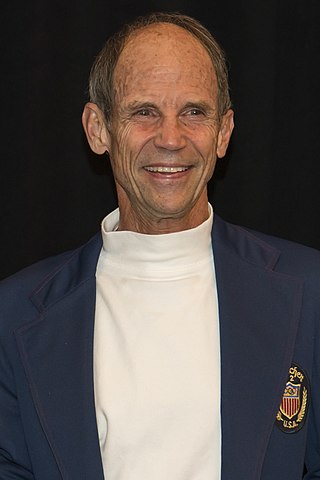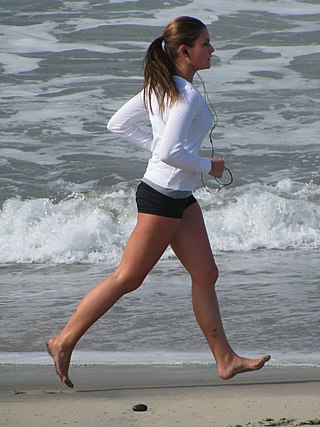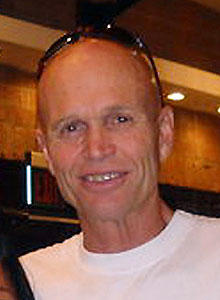
Running is a method of terrestrial locomotion allowing humans and other animals to move rapidly on foot. Running is a type of gait characterized by an aerial phase in which all feet are above the ground. This is in contrast to walking, where one foot is always in contact with the ground, the legs are kept mostly straight and the center of gravity vaults over the stance leg or legs in an inverted pendulum fashion. A feature of a running body from the viewpoint of spring-mass mechanics is that changes in kinetic and potential energy within a stride co-occur, with energy storage accomplished by springy tendons and passive muscle elasticity. The term running can refer to any of a variety of speeds ranging from jogging to sprinting.

The marathon is a long-distance foot race with a distance of 42.195 km, usually run as a road race, but the distance can be covered on trail routes. The marathon can be completed by running or with a run/walk strategy. There are also wheelchair divisions. More than 800 marathons are held throughout the world each year, with the vast majority of competitors being recreational athletes, as larger marathons can have tens of thousands of participants.

Long-distance running, or endurance running, is a form of continuous running over distances of at least 3 km (1.9 mi). Physiologically, it is largely aerobic in nature and requires stamina as well as mental strength.

Road running is the sport of running on a measured course over an established road. This differs from track and field on a regular track and cross country running over natural terrain.
Jack Tupper Daniels is an exercise physiologist, running coach and a coach of Olympic athletes. On March 21, 2013, he was named the head coach of the Wells College men's and women's cross country programs. He received his doctoral degree in exercise physiology at the University of Wisconsin–Madison. Named "The World's Best Coach" by Runner's World magazine, he led SUNY Cortland runners to eight NCAA Division III National Championships, 31 individual national titles, and more than 130 All-America awards. Daniels outlined his training philosophies in the 1998 book, Daniels' Running Formula. He mentors and coaches some of America's top distance runners in the country.

An ultramarathon, also called ultra distance or ultra running, is any footrace longer than the traditional marathon length of 42.195 kilometres. Various distances are raced competitively, from the shortest common ultramarathon of 50 kilometres (31 mi) to over 200 miles (320 km). 50k and 100k are both World Athletics record distances, but some 100 miles (160 km) races are among the oldest and most prestigious events, especially in North America.

Trail running is a type of running that takes place outdoors, in natural environments with few paved roads. It is similar to both mountain and fell running. Unlike road running and track running, it generally takes place on outdoor trails, often in mountainous terrain, and often includes significant ascents and descents. It is difficult to definitively distinguish trail running from cross country running. In general, however, cross country running is a discipline governned by the IAAF, which is typically raced over shorter distances, while trail running is overseen by ITRA and includes longer races.

Robert Keyser "Bob" Schul is a former American long-distance runner. As of 2016, he is the only American to have won an Olympic gold medal in the 5000 m, at the 1964 Summer Olympics in Tokyo.

Dean Karnazes, is an American ultramarathon runner, and author of Ultramarathon Man: Confessions of an All-Night Runner, which details ultra endurance running for the general public.

Jeff Galloway is an American Olympian and the author of Galloway's Book on Running.
Long slow distance (LSD) is a form of aerobic endurance training used in sports including running, rowing, skiing and cycling. It is also known as aerobic endurance training, base training and Zone 2 training. Physiological adaptations to LSD training include improved cardiovascular function, improved thermoregulatory function, improved mitochondrial energy production, increased oxidative capacity of skeletal muscle, and increased utilization of fat for fuel. Ernst van Aaken, a German physician and coach, is generally recognized as the founder of the LSD method of endurance training.

Ted Corbitt was an American long-distance runner. The first African-American to run the marathon at the Summer Olympics and the founding president of New York Road Runners, Corbitt is often called "the father of American long distance running." He was also an ultramarathon pioneer, helping to revive interest in the sport in the United States in the 1960s and 1970s. New York Times columnist Robert Lipsyte called Corbitt a "spiritual elder of the modern running clan". In a Runner's World feature honoring lifetime achievement, writer Gail Kislevitz called Corbitt a "symbol of durability and longevity". Corbitt was among the first five runners to be inducted into the National Distance Running Hall of Fame, and the first to be inducted into the American Ultrarunning Hall of Fame.

Barefoot running, also called "natural running", is the act of running without footwear. With the advent of modern footwear, running barefoot has become less common in most parts of the world but is still practiced in parts of Africa and Latin America. In some Western countries, barefoot running has grown in popularity due to perceived health benefits.
Running economy (RE) measures runners' energy utilization when running at an aerobic intensity, and many physiological and biomechanical factors contribute to it. Oxygen consumption (VO2) is the most commonly used method for measuring running economy, as the exchange of gases in the body, specifically oxygen and carbon dioxide, closely reflects energy metabolism. Those who are able to consume less oxygen while running at a given velocity are said to have a better running economy. However, straightforward oxygen usage does not account for whether the body is metabolising lipids or carbohydrates, which produce different amounts of energy per unit of oxygen; as such, accurate measurements of running economy must use O2 and CO2 data to estimate the calorific content of the substrate that the oxygen is being used to respire.
Tera Moody is a retired American athlete, who competes in the marathon and other long distance running events. Moody represented the United States at the 2009 World Championships in the marathon. She also placed 17th in the 2011 World Championships in 2:32:04

Arthur "Al" Howie was a Canadian long-distance runner who won more than fifty marathons, ultramarathons, and multiday races in over two decades, including the 1991 Trans Canada Highway run in the record time of 72 days and 10 hours. A brass plaque on Victoria's Mile Zero marker commemorates this athletic event for which he raised $750,000 for a fund for children with special needs. Two weeks after running across Canada he won the Sri Chinmoy 1300 Miler in New York improving on his own world record time. Both the Trans Canada run and the 1,300-mile (2,100 km) race qualified for the Guinness Book of Records. He lived in Duncan, B.C., from 2005 until his death in 2016. He had been receiving treatment for Diabetes I. The City of Duncan awarded him the Perpetual Trophy for Excellence and Sportsmanship in December 2007, and in 2014 he was inducted into The Greater Victoria Sports Hall of Fame.
The Road Runners Club is an association of road runners formed in 1952 to encourage the athletic discipline of road running in the United Kingdom. Since then it has developed into a club that embraces the concept of assisting in the promotion of and training for road races and long distance track races. The most popular distances amongst current members are the half marathon and marathon for which much training advice is available to members. The club operates a unique club championship whereby members send in the verifiable results from any sanctioned race in the world and the results are entered throughout a calendar year. This has proved popular amongst all levels of ability and resulted in 280 championship entries for 2019. The club now embraces all runners from the park run to the marathon and ultra marathon competitors with comprehensive advice on its website.

Micah True, born Michael Randall Hickman and also known as Caballo Blanco, was an American ultrarunner from Boulder, Colorado, who received attention because of his depiction as a central character in Christopher McDougall's book Born to Run. True's inclusion in the book garnered him some attention in ultrarunning circles, and some readers credited him as their inspiration for taking up the sport.

Sage Clifton Read Canaday is an American long-distance runner and ultramarathoner.
Robert Young is an English endurance runner, who was originally known for multiple high profile marathons and long distance runs. He later took part in a failed trans-United States attempt, in which he was found to have cheated.













